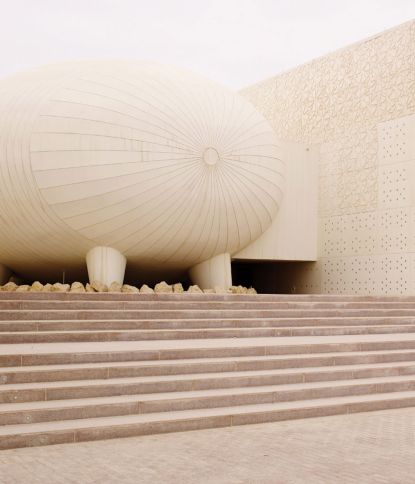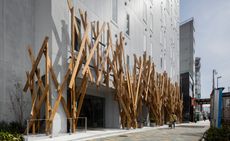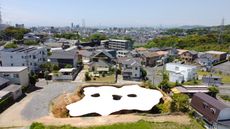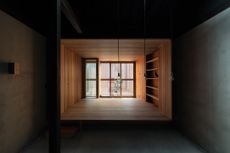In memoriam: Arata Isozaki (1931 – 2022)
The legendary Japanese architect Arata Isozaki dies on 29th December 2022; we celebrate his life and work
- (opens in new tab)
- (opens in new tab)
- (opens in new tab)
- Sign up to our newsletter Newsletter

The Japanese architect Arata Isozaki has died at his home in Okinawa at the age of 91. Isozaki carved a unique path in the architecture field with his eye-catching designs, which blended postmodernism with metabolism. His work has been recognised globally through several accolades, including the 2019 Pritzker Prize – one of the industry’s highest honours.

Palau Sant Jordi at Montjuic, Barcelona, Spain, 1990.
Arata Isozaki dies at the age of 91
Isozaki studied at the University of Tokyo. The Oita-born architect gained professional experience working under another famed architect and fellow countryman Kenzo Tange, who has been known for balancing modernist architecture and traditional Japanese styles. Isozaki then went on to set up his own studio, Arata Isozaki & Associates, in 1963. He also founded a branch of his practice in Italy in 2005 with Andrea Maffei, showcasing his admiration for travel and an approach that manages both site-specific and international influences.
‘I wanted to see the world through my own eyes, so I travelled around the globe at least ten times before I turned thirty. I wanted to feel the life of people in different places and visited extensively inside Japan, but also to the Islamic world, villages in the deep mountains of China, South East Asia, and metropolitan cities in the US. I was trying to find any opportunities to do so, and through this, I kept questioning, “What is architecture?”‘ has said Isozaki of his passions and explorations.

The Art Tower in Mito by Isozaki, Ibaraki, Japan, 1990
Among Isozaki's great works include the Ōita Prefectural Library, Japan (1966); the MOCA, Los Angeles (1986); the Palau Sant Jordi at Montjuic, Barcelona, Spain (1990); The Art Tower in Mito by Isozaki, Ibaraki, Japan (1990); the Kyoto Concert Hall (1995); the Shenzhen Cultural Centre (2007); and the Allianz Tower in Milan (which was completed in 2015 with his partner Andrea Maffei).
‘Extravagance for me is complete silence – nothing less,’ has said Isozaki in a film shown during the 2018 Venice Biennale. Integral to the late architectural legacy was the Japanese concept of ma – the void and time that lies between all things – which has had a profound influence on his work.
‘Isozaki was one of the first Japanese architects to build outside of Japan during a time when western civilizations traditionally influenced the East, making his architecture - which was distinctively influenced by his global citizenry - truly international. In a global world, architecture needs that communication,’ said Tom Pritzker, chairman of the Hyatt Foundation, on Isozaki's Prize win in 2019.
isozaki.co.jp (opens in new tab)
Ellie Stathaki is the Architecture Editor at Wallpaper*. She trained as an architect at the Aristotle University of Thessaloniki in Greece and studied architectural history at the Bartlett in London. Now an established journalist, she has been a member of the Wallpaper* team since 2006, visiting buildings across the globe and interviewing leading architects such as Tadao Ando and Rem Koolhaas. Ellie has also taken part in judging panels, moderated events, curated shows and contributed in books, such as The Contemporary House (Thames & Hudson, 2018) and Glenn Sestig Architecture Diary (2020).
-
 Last chance to see: Marc Newson’s all-blue designs in Athens
Last chance to see: Marc Newson’s all-blue designs in AthensGagosian gallery Athens presents new blue furniture and objects by Marc Newson
By Rosa Bertoli • Published
-
 Sapir Bachar’s love for silver makes for abstract jewellery forms
Sapir Bachar’s love for silver makes for abstract jewellery formsSapir Bachar’s fashion background informs her eponymous jewellery brand
By Pei-Ru Keh • Published
-
 Spectacular Wyoming ranch sits within a restored working landscape
Spectacular Wyoming ranch sits within a restored working landscapeThis Wyoming ranch by CLB Architects offers a new approach to the Western architectural tradition, combining daring and functional modern design with a welcoming character
By Jonathan Bell • Published
-
 Modern Japanese houses inspiring minimalism and avant-garde living
Modern Japanese houses inspiring minimalism and avant-garde livingWe tour the best Japanese architecture and modern Japanese houses designed by international and local architects that open up possibilities for all types of lifestyle, from minimalist to communal in Japanese architecture.
By Ellie Stathaki • Published
-
 Shiguchi is a Japanese cultural retreat that bridges tradition and the 21st century
Shiguchi is a Japanese cultural retreat that bridges tradition and the 21st centuryShiguchi is a new Japanese cultural hub set amid nature, by artist and collector Shouya Grigg
By Catherine Shaw • Last updated
-
 № 001 Minami Aoyama is an Aston Martin architectural venture in Tokyo
№ 001 Minami Aoyama is an Aston Martin architectural venture in Tokyo№ 001 Minami Aoyama is a bespoke residence for an Aston Martin collector, located in the heart of Tokyo’s Omotesando; shaped by Aston Martin, Vibroa, and Intentionallies, it’s due for completion in 2023
By Jonathan Bell • Last updated
-
 Kengo Kuma’s One@Tokyo hotel juxtaposes tradition and modernity
Kengo Kuma’s One@Tokyo hotel juxtaposes tradition and modernityOne@Tokyo's Kengo Kuma design is the latest project from Agora Hospitalities Co and Sky Hospitality
By Hannah Silver • Published
-
 Explore Junya Ishigami's cave-like house and restaurant design
Explore Junya Ishigami's cave-like house and restaurant designJapanese architect Junya Ishigami has completed his impressive, cave-like Home/Restaurant project in his home country's Yamaguchi
By Jens H Jensen • Last updated
-
 Atelier Luke, Japan + Australia: Wallpaper* Architects’ Directory 2022
Atelier Luke, Japan + Australia: Wallpaper* Architects’ Directory 2022Wallpaper* Architects’ Directory is our annual round-up of exciting emerging architecture studios. Next up, Atelier Luke, with offices in Australia and Japan, joins our 2022 list
By Martha Elliott • Last updated
-
 This Hayama house offers a twist on Japanese seaside living
This Hayama house offers a twist on Japanese seaside livingA new house in Hayama by architects Case-Real offers a new take on living in the Japanese seaside town
By Jens H Jensen • Last updated
-
 Heatherwick Studio unveils undulating mixed-use Tokyo scheme design
Heatherwick Studio unveils undulating mixed-use Tokyo scheme designBy Ellie Stathaki • Last updated










